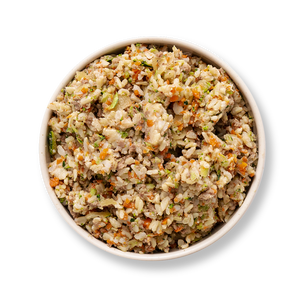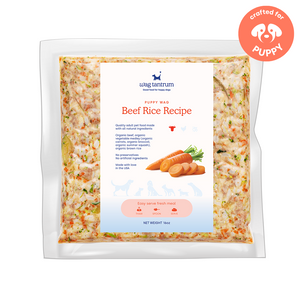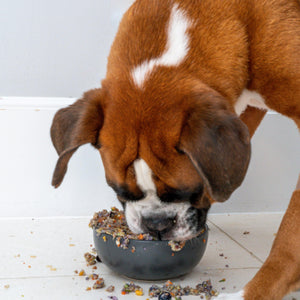The New Year Dog Exercise Guide
The New Year Dog Exercise Guide: Simple Workouts for All Dogs
 Did you know that a simple one-hour walk can burn up to 200 calories for both you and your dog? Exercise isn't just about staying fit - it's essential for all dogs to maintain physical and mental well-being. In fact, dogs that get at least 30 minutes of daily exercise are more likely to stay calm throughout the day.
Did you know that a simple one-hour walk can burn up to 200 calories for both you and your dog? Exercise isn't just about staying fit - it's essential for all dogs to maintain physical and mental well-being. In fact, dogs that get at least 30 minutes of daily exercise are more likely to stay calm throughout the day.
However, finding the right exercise routine can be challenging. Not all activities suit every dog, and factors like age, breed, and health conditions play crucial roles in determining the perfect workout. Additionally, combining exercise with proper nutrition, including healthy dog food and fresh ingredients from pet fresh food companies, helps create a comprehensive wellness plan that keeps our furry friends active and healthy.
We've created this guide to help you develop an exercise routine that works for your dog's specific needs, whether they're energetic puppies or senior companions needing gentle movement to maintain their health.
Seasonal Exercise Planning for Dogs
When winter winds howl or summer temperatures soar, we need to adjust our dogs' exercise routines. Most dogs benefit from 30-45 minutes of large-muscle exercise daily [1], consequently, we must plan activities that work in any weather.
During summer months, we recommend checking the pavement temperature before walks. Specifically, when air temperature reaches 86 degrees, asphalt can heat up to 135 degrees [2]. To protect our furry friends, we should place our hand on the surface for 10 seconds - if it's too hot for us, it's too hot for them [3].
Furthermore, winter brings its own challenges. Here are some indoor activities we can try when outdoor exercise isn't possible:
-
Stair exercises for cardiovascular fitness
-
Hide-and-seek games with treats
-
Indoor obstacle courses using household items
-
Tug-of-war for muscle strengthening
-
Hallway fetch sessions
Generally, small and short-legged dogs need extra attention in extreme weather, since their bodies absorb heat closer to the ground [2]. For outdoor activities in challenging weather, we should consider protective gear like booties for paw protection and appropriate clothing for short-haired breeds.
Remember to watch for signs of overexertion in any season. If our dogs show symptoms like excessive panting, seeking shade, or reluctance to move, it's time to head indoors [2]. By adapting exercise routines to seasonal changes, we can keep our dogs active and healthy throughout the year.
Combining Fresh Food and Exercise
Proper nutrition timing plays a crucial role in our dogs' exercise success. Let's explore how to combine meals and workouts effectively for all dogs.
We should wait at least 2 hours after feeding before exercising our dogs [5]. Moreover, after exercise, it's essential to wait 30 minutes before offering food [6]. This timing helps prevent digestive issues and reduces the risk of bloat, particularly in active dogs.
Hydration deserves special attention. Our dogs need approximately 60mL of water per kilogram of body weight daily [7]. Notably, active dogs require more water based on:
-
Temperature and exercise duration
-
Efficiency of panting
-
Individual activity levels
Fresh food makes a significant difference in exercise recovery. Dogs fed moisture-rich food (around 72% moisture) stay better hydrated compared to those on dry kibble (10% moisture) [8]. Accordingly, many fresh dog food companies now offer specially formulated meals for active dogs.
Essential nutrients for exercise recovery include protein and fat. Active dogs need higher protein levels (26% or more) [9], while fat helps fuel muscles effectively. We've found that feeding 18-24 hours before exercise optimizes fat metabolism [9].
Post-workout, we should offer small amounts of cool water rather than letting our dogs gulp large quantities [10]. For optimal recovery, carbohydrate replacement becomes important, especially if our dogs participate in multiple activities throughout the day [10].
Creating a Balanced Workout Schedule
Creating an effective exercise routine starts with understanding our dogs' unique needs. Initially, we should aim for 30-45 minutes of daily physical activity [11], though this varies based on breed and age.
Above all, variety keeps our dogs engaged. Here are some activities we can mix into their weekly schedule:
-
Walking or jogging for cardiovascular health
-
Swimming for low-impact exercise
-
Fetch games with different toys
-
Agility training for mental stimulation
Important to realize, rest days are just as crucial as active days. We've found that dogs should rest 60-80% of the day, which equals 15-20 hours [2]. In essence, this doesn't mean complete inactivity - it means gentle movement coupled with mental relaxation.
For high-energy breeds, we recommend splitting exercise into multiple sessions. A 10-minute intense play followed by a 30-second walk, then another 10-second sprint creates an effective workout pattern [3]. After any intense session, we should allow 10-15 minutes of free movement [2].
Watch for signs that indicate our dogs need rest: excessive panting, pale gums, or reluctance to continue [12]. Following intense workouts, our dogs need 36-48 hours for proper recovery [2]. This recovery period helps prevent injuries and ensures our dogs maintain their enthusiasm for exercise.
Conclusion
Exercise stands as a cornerstone of our dogs' well-being, making a significant difference in their physical health and behavior. Through proper planning, we can create effective workout routines that adapt to seasonal changes while considering our pets' individual needs.
Successful dog exercise programs combine three key elements: weather-appropriate activities, proper nutrition timing, and balanced workout schedules. Most importantly, watching our dogs' responses helps us adjust these elements for their comfort and safety.
Rest remains equally vital as activity. While maintaining regular exercise schedules, we should pay attention to recovery periods and signs of fatigue. This balanced approach ensures our dogs stay healthy, happy, and eager for their next workout session.
Remember that every dog differs in their exercise needs and capabilities. Starting slowly and gradually increasing activity levels helps build lasting habits that benefit both us and our furry companions. Through consistent, thoughtful exercise planning, we can help our dogs maintain optimal health throughout their lives.








